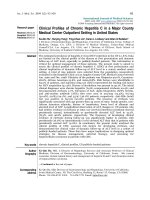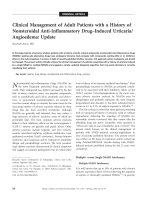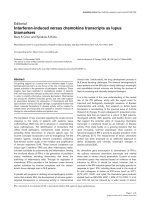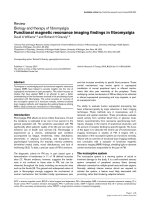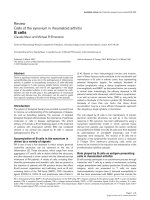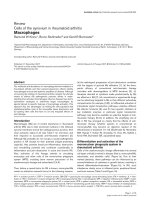Báo cáo y học: "Clinical diagnosis versus autopsy findings in polytrauma fatalities" pps
Bạn đang xem bản rút gọn của tài liệu. Xem và tải ngay bản đầy đủ của tài liệu tại đây (306.29 KB, 9 trang )
ORIGINAL RESEARCH Open Access
Clinical diagnosis versus autopsy findings in
polytrauma fatalities
Claas T Buschmann
1*
, Patrick Gahr
2
, Michael Tsokos
1
, Wolfgang Ertel
2
, Johannes K Fakler
2,3
Abstract
Objectives: The aim of the study was to determin e if differences in clinical diagnosis versus autopsy findings
concerning the cause of death in polytrauma fatalities would be detected in 19 cases of fatal polytrauma from a
Level 1 trauma centre.
Methods: Clinical diagnoses determining the cause of death in 19 cases of fatal polytrauma (2007 - 2008) from a
Level 1 trauma centre were correlated with autopsy findings.
Results: In 13 cases (68%), the clinical cause of death and the cause of death as determined by autopsy were
congruent. Marginal differences occurred in three (16%) patients while obvious differences in interpreting the
cause of death were found in another three (16%) cases. Five fatalities (three with obvious differences and two
with marginal differences) were remarked as early death (1-4 h after trauma) and one fatality with marginal
differences as late death (>1 week after trauma). Obvious and marginal discrepancies mostly occurred in the early
phase of treatment, especially when severely injured patients were admitted to the emergency room undergoing
continued cardiopulmonary resuscitation, i. e. limiting diagnostic procedures, and thus the clinical cause of death
was essentially determined by basic emergency diagnostics.
Conclusions: Autopsy as golden standard to define the cause of death in fatal polytrauma varies from the clinical
point of view, depending on the patient’s pre-existing condition, mechanism of polytrauma, necessity of traumatic
cardiopulmonary resuscitation, survival time, and thus the possibility to perform emergency diagnostics. An autopsy
should be performed at least in cases of early fatal polytrauma to help establishing the definite cause of death.
Moreover, autopsy data should be included in trauma registries as a quality assessment tool.
Introduction
Polytrauma, defined as a trauma pattern with an Injury
Severity Score (ISS) >16 points and consisting of various
injuries of which at least one is life-threatening, is asso-
ciated with a mortality rate up to 23% [1,2]. Severe
injury is the leading cause of death among children,
adolescents, and young adults (ages 1-44), and repre-
sents the third most common cause of death for all ages
in the western countries, afte r cardiovascular diseases
and cancer [3]. Frequent causes of death in trauma fatal-
ities are at first injuries to the central nervous system
(40-50%), followed by hemorrhage (20-40%) and multi-
ple organ failure (MOF), accounting for a further 2-10%.
About 53-69% of deaths occur prior to admission to
hospital, and 7.3% of polytrauma patients are reported
to have received cardiopulmonary resuscitation (CPR)
during pre-hospital or emergency room (ER) treatment
[2,4].
In the last decades, numerous clinical implementa-
tions, scoring systems and guidelines for improving
quality of treatment in polytrauma patients such as the
Advanced Trauma Life Support®-(ATLS)-Program have
been set up [2]. In cases of trauma death, review of
autopsy data is also used as part of the trauma quality
assurance (QA) process, and autopsy rates are queried
by the American College of Surgeons Committee on
Trauma in their reviews [5]. Generally, autopsy assess-
ment to in- and out-of-hospital fatalities is a valuable
contributor to medical education [6], and current litera-
ture supports the concept that autopsies are useful in
uncovering a potentially missed diagnosis in trauma
* Correspondence:
1
University Medical Centre Charité - University of Berlin, Institute of Legal
Medicine and Forensic Sciences, Turmstr. 21, Building L, 10559 Berlin,
Germany
Full list of author information is available at the end of the article
Buschmann et al. Scandinavian Journal of Trauma, Resuscitation and Emergency Medicine 2010, 18:55
/>© 2010 Buschmann et al; licensee BioMed Central Ltd. This is an Open Access article distributed under the terms of the Creative
Commons Attribution License (http://cre ativeco mmons.org/licenses /by/ 2.0), which permits unrestricted use, distribu tion, and
reproduction in any medium, provided the original work is properly cited.
patients [7-11]. Especially in death after trauma, autopsy
data can provide sufficient data to assist in determining
the presence of missed injuries contributory to death
[12], and also confirming the clinical cause of death.
However, recent studies focusing on causes of death
after injury are - with few exceptions [11-13] - solely
based on clinical records [2-4,14]. Moreover, in recent
publications the value of autopsies after severe trauma is
discussed to offer only little additional information [5,6],
i.e., no major or minor discrepancies, that may have
altered the patient’s therapy or survival time in terms of
a preventable death or missed injuries.
Theaimofthepresentstudywastodetermineifdif-
ferences in clinical diagnosis versus autopsy findings
concerning the cause of death in polytrauma f atalities
would be detected in 19 cases of fatal polytrauma from
a Level 1 trauma centre. The value of forensic autopsy
in polytrauma fatalities, especially in cases of early dea th
and continued CPR on arrival at the ER (when intended
diagnostic procedures possibly were not completed at
the occurrence of death) is discussed.
Materials and methods
Our patient collective was excerpted from 29 cases of
fatal polytrauma (2007-01-01 - 2008-12-31) from the
Department of Orthopedic, Trauma and Reconstructive
Surgery at Campus Benjamin Franklin, University Medi-
cal Centre Charité - University of Berlin/Germany, a
Level I university trauma Center. The total number of
polytrauma patients admitted to this hospital during the
study period was 174 (mortality rate 16.6%). Polytrauma
fatalities that did not have an a utopsy performed were
excluded.
By order from the public prosecutor’s office, 19 of
these 29 patients were autopsied at the Institute o f
Legal Medicine and Forensic Sciences, Universi ty Medi -
cal Centre Charité - University of Berlin/Germany
(autopsy rate 65.5%). Median a ge was 48 years (24-90
years), 15 patients were male and 4 female. Clinical
records, death certificates with date and time of death
and final autopsy protocols were evaluated, and then
time of death was assigned to 1 of 3 mortality types
according to Trunkey ’s trimodal temporal distribution
model [ 15]. Beyond that, clinical diagnoses determining
the cause of death in these 19 fatalities were compared
to autopsy findings. For determination of discrepant
diagnoses, clinical records were reviewed separately,
independently, and retrospectively without knowledge of
autopsy findings and vice versa by the authors from tw o
different departments, performing a single case analysis
with an interdisciplinary approach. Clinical diagnoses
were annotated based on hospital charts and death certi-
ficates, and autopsy diagnoses were annotated based on
final autopsy reports. Discrepancies were classified in
obviou s and marginal differences. Obvious discrepancies
were defined as autopsy findings that were clinically
unsuspected, incorrect or interpreted differently when
compared to the clinical records and death certificate,
the latter presenting different pathophysiogical pathways
contributory to death. Marginal discrepancies were
defined as unsuspected or incorrect findings at autopsy
when compared to clinical records that did not directly
contribute to the patient’s death but likely would have
had an impact on the patient ’s treatment or hospital
course. Referring to literature, it was questioned whether
the patient’s death would have been preventable in cases
of additional and/or incorrect clinical diagnoses or not
[16].
Results
Injury patterns
High velocity traffic accid ents were the leading cause of
polytrauma (n = 11/52%), followed by fall from height
(n = 5/26%). Injury patterns were caused by traffic acci-
dents as pedestrian (n = 4) or car-/(motor)cycle driver
(n = 7), fall from height (n = 5), homicidal stab attack
(n = 1), work place accident (n = 1) and train overrun
(n = 1). The median ISS at admission to the ER was
scored 45 points (± 15.5 SD), ranging from 33 to 75
points. The stated ISS sco rings in this study were solely
based on clinical findings.
Traffic accidents caused multiple trauma patterns to
the whole b ody, including severe traumatic brain injury
(sTBI), multiple fractures and contusions of extremities
and trunk as well as hollow organ and great vessel
lacerations; incident-related specific injury patterns were
not identified in this group. Falls from height mainly
presented sTBI as cause of death; although blunt cardiac
injuries have been described to occur frequently at least
in falls exceeding >6 m [17], in our small collective suc h
injuries were not diagnosed. Other mechanisms of
trauma resulted in corresponding injuries: isolated sharp
thorax trauma for homicidal stab attack (n = 1), suicidal
train overrun for polytrauma including lower leg ampu-
tation (n = 1), and work place accident (patient bruised
by an 18 00-kg-transformator in a hoistway, n = 1) for
blunt polytrauma.
Cause of death
The prevalence of discrepancies in our collective
reached 32% (Figure 1), and obvious differ ences
occurred in 3 patients (16%) while marginal differences
in interpreting the cause of death were found in another
3 cases (16%). In 13 cases (68%), the clinical cause of
death and the cause of death determined by forensic
autopsy were congruent, but 2 of these cases (15%) had
been explanted for organ donation purposes before
autopsy, thus autopsy approved the clinical cause of
Buschmann et al. Scandinavian Journal of Trauma, Resuscitation and Emergency Medicine 2010, 18:55
/>Page 2 of 9
death, but could not reveal any discrepancies with
regard to the explanted organs. None of the fatalities
were classified as preventable deaths. A detailed list of
the included patients is given in Table 1.
Survival time and discrepant diagnoses
None of the studied fatalities occurred as immediate
death (on scene/1-59 min after trauma), conceivably due
to the fact that resuscitation procedures at the site of
the incident and transport to the ER took more than
one hour in our study population. 9 fatalities (47%)
occurred as early death (Emergency Room [ER] or
Operation Room [OR]/1-4 h after trauma) and 6 (32%)
fatalities as late death (> 1 week after trauma). Four
(21%) patients survived between 4 h and 1 week, thus
not being classif iable in Trunkey’s scheme (Figure 2).
Median time interval between traumatic incident and
admission to the ER was 1:02 h, and median survival
time from the traumatic incident was 5:35 h.
4 patients from the early death group were brought to
the ER undergoing continued CPR or necessitated CPR
during immediate ER course, i.e. limiting emergency
diagnostics, and thus the clinical cause of death was
essentially determined by means of basic emergency
diagnostics and physical examination. 3 of these patients
were forensically regarded as incongruent concerning
the cause of death (1 with obvious differences, 2 with
marginal differences).
In summary, 5 fatalities presenting discrepancies at
autopsy (3 with obvious differences and 2 with marginal
differences) were remarked as early death and 1 with
marginal differences as late death. Obvious und mar-
ginal discrepancies concerning the cause of death mostly
occurred in the early phase of treatment (n = 5/83%); 3
of the 6 discrepant fatalities arrived at the ER
undergoing continued CPR or necessitated CPR in
immediate clinical course.
In the following, we present short case reports of the
incongruent polytrauma fatalities in our study group.
Obvious differences
The three fatalities presenting obvious differences at
autopsy when compared to clinical diagnoses, survived
the traumatic incident between 2:10 h and 2:50 h (med-
ian 2:46 h) and reached the ER 1:19 h after accident
(median). Median in-hospital survival time was 1:27 h,
and 2 of these patients were brought to the ER under-
going continued CPR or necessitated CPR during ER
diagnostic procedures.
Exemplary case reports
Table 2 gives an overview of ER diagnostic procedures
in the reported exemplary case reports.
Case no. 7
The patient (m, 27 y) sustained a high velocity car acci-
dent. He arrived intubated at the ER 1:13 h after the
accident where sTBI and severe blunt chest trauma with
bilateral lung contusions were diagnosed (ISS: 59
points). Chest drains were applied, but artificial ventila-
tion remained difficult (P
a
O
2
maximum 70 mmHg and
P
a
CO
2
of 70 mmHg). The patient was brought rapidly
to the OR, ER diagnostics were based on physical exam-
ination, ultrasound performance, thoracic and pelvic x-
ray scans and whole-body spiral computer tomography,
showing sTBI, severe chest injury, pelvic trauma (left-
sided iliac wing fracture, AO/OTA type 61-A2), serial
fractures of t he processi transversi of the vertebral col-
umn and a small retroperitoneal hematoma. During
immediate damage control surgery for thoracic trauma,
Figure 1 Comparison of the causes of death before and after autopsy (n = 19).
Buschmann et al. Scandinavian Journal of Trauma, Resuscitation and Emergency Medicine 2010, 18:55
/>Page 3 of 9
Table 1 List of included patients
no sex age mechanism
of
polytrauma
ISS survival
time (hh:
mm/days if
appropriate)
cause of death
(clinically)
cause of death
(autoptically)
congruent? CPR marginal
difference
obvious
difference
1 f 41 traffic
accident
(car)
51 2:43 thorax trauma thorax trauma yes -
2 f 24 homicidal
stab attack
75 1:00 hemorrhagic
shock due to
multiple
thoracal stab
wounds
fatal bleeding due to
multiple thoracal stab
wounds, bilateral
hematopneumothorax
no - bilateral
hematopneumothorax?
++ -
3 m 46 traffic
accident
(car)
34 2:15 hemorrhagic
shock due to
liver rupture,
thorax trauma,
contusio cordis
thorax trauma,
exsanguination from
liver rupture
yes -
4 m 48 traffic
accident
(car)
50 184 days MOF/lung artery
embolism
MOF no - lung artery
embolism?
- + -
5 f 75 traffic
accident
(cyclist)
38 15 days sTBI sTBI yes -
6 m 49 fall from
height
54 9:35 sTBI sTBI yes -
7 m 27 traffic
accident
(car)
59 2:50 sTBI, lung failure,
hemorrhagic
shock, thorax
trauma
sTBI, bilateral lung
contusion, pelvic
trauma
no - pelvic trauma ? +
8 m 72 traffic
accident
(pedestrian)
43 2:46 thorax trauma,
heart contusion,
hemorrhagic
shock
thorax trauma,
pericardial
tamponade
no - pericardial
tamponade?
+ - +
9 m 49 traffic
accident
(cyclist)
43 9 days sTBI sTBI - explanted yes - explanted -
10 m 45 train overrun 75 2:22 sTBI/
hemorrhagic
shock from
Sinus sagittalis
superior
bleeding
sTBI no - hemorrhagic
shock?
- + -
11 m 36 fall from
height
38 20:07 sTBI sTBI yes -
12 m 49 work place
accident
75 2:10 blunt thoraco-
abdominopelvic
trauma
fatal bleeding due to
pelvic trauma
no - pelvic trauma? + - +
13 m 41 traffic
accident
(cyclist)
41 1:40 sTBI, blunt
abdominal and
pelvic trauma
sTBI, blunt abdominal
and pelvic trauma
yes -
14 m 84 fall from
height
33 5 days sTBI sTBI yes -
15 m 57 fall from
height
45 7:15 blunt abdominal
and pelvic
trauma
blunt abdominal and
pelvic trauma
yes -
16 m 33 traffic
accident
(cyclist)
75 1:10 aortic rupture aortic rupture yes +
17 m 45 traffic
accident
(cyclist)
75 6 days sTBI sTBI - explantated yes - explanted -
Buschmann et al. Scandinavian Journal of Trauma, Resuscitation and Emergency Medicine 2010, 18:55
/>Page 4 of 9
the man had to be resuscitated which remained unsuc-
cessful; total survival time was 2:50 h, in-hospital survi-
val time accounted for 1:37 h.
Based on clinical assessments, trauma surgeons
assumed as cause of death a cardiac arrest caused by
severe thorax trauma with consecutive lung failure and
sTBI, while autopsy reported - besides the correct clini-
cal diagnoses - a large retroperitoneal hematoma in the
rearward fat tissue and consecutive signs of hemorrhagic
shock as a further potentially lethal injury. While
hemorrhagic shock was also diagnosed and addressed by
orthopedic surgeons, the stable pelvic fracture as well as
the serial fractures of the processi transversi of the ver-
tebral column was not seen as the main source of bleed-
ing. According to the trauma surgeons, continued
ventilation problems with hypoxia and massive hyper-
capniaduetoseverethoracictraumainconjunction
with sTBI were responsible for deat h primarily: the pel-
vic and vertebral column trauma had already been
diagnosed in the ER, but respiratory failure was given
priority at admission. Although death would not have
been evitable, the case was forensically considered as an
obvious difference since the retro peritoneal destructi ons
with subsequent bleeding were not regarded clini cally as
a relevant factor of death.
Case no. 8
The patient (m, 72 y) was overrun by a car; 1:19 h later
he was admitted to the ER. During immediate ER
course, CPR efforts were necessary, and initial ISS was
scored 43 points. Severe chest trauma with bilateral
serial costal fractures, heart and lung contusions as well
as hemorrhagic shock was diagnosed; chest drains were
applied. Physical examination, X-ray scans, abdominal
ultrasound and spiral computertomography were per-
formed immediately, confirming the chest trauma and
showing a hypertrophied r ight heart without signs of
pericardial effusion. After extensive CPR, the man was
Table 1 List of included patients (Continued)
18 m 76 traffic
accident
(pedestrian)
43 7:46 sTBI sTBI yes -
19 m 95 fall from
height
41 21 days lung artery
embolism
lung artery embolism yes -
Figure 2 Survival time according to Trunkey’s trimodal temporal distribution model (n = 19).
Buschmann et al. Scandinavian Journal of Trauma, Resuscitation and Emergency Medicine 2010, 18:55
/>Page 5 of 9
pronounced dead 1:27 h after admission. Total survival
time was 2:46 h; trauma surgeons blamed a hemorrhagic
shock for the cardiac arrest.
Autopsy confirmed the severe chest trauma with sev-
eral bilateral rib fractures as well as heart and lung
contusions, but furthermore yielded a pericardial tampo-
nade with 280 ml of blood, caused by a 10 mm trau-
matic rupture of the V. cava inferior at the mouth of
the right atrium which was considered forensically as
compe titiv e cause of death. It could not be clarified for-
ensically to what extent the rupture of V. cava inferior
was due to the original thoracic trauma or to ponderous
CPR efforts with a chest drain applied to the right
pleura which was probably moved during extensive
closed chest CPR: the tip of the chest drain was found
to be located near the mouth of the right atrium.
Despite the non-diagnosed possible iatrogenic pericar-
dial tamponade, death was considered unpreventable
because of the severity of the chest trauma.
Case no. 12
The patient (m, 49 y) was clamped by an 1800-kg-trans-
formator that trapped him in a hoistway. After difficult
extricati on by the fire brigade he reached the ER 1:45 h
after the accident endotracheally intubated and under-
going continued CPR. Initial ISS was scored 75 points,
and emergency diagnostics consisted of basic emergency
diagnostics (physical examination, thoracic and pelvic X-
ray scans) as extensive CPR was continued for another
0:25 h before the patient was pronounced dead. Survival
time from the accident was 2:10 h. Based upon previous
surgical examination and x-ray scans, ER physicians
assumed as cause of death a blunt chest, abdomi nal and
pelvic trauma, but autopsy solely showed - besides signs
of extensive CPR - a fatal bleeding from the pelvic ring
disruption with traumatic rupture of A. and V. iliaca
communis dextra. Organs in thorax and upper abdomen
were nearly unaltered. Although merely the pelvic injury
led to death by exsanguin ation, the patient’s demise was
considered una voidable as the blood loss already neces-
sitated CPR on scene and the patient arrived at the ER
without signs of life for a total time of 1:45 h.
Marginal differences
In the 3 fatal polytrauma issues presenting marginal dif-
ferences concerning the cause of death, the patients
reached the ER 1:00 h after the accident (median). 2
patients survived in-hospital for 0:12 h and 2:22 h
respectively, one patient survived for 184 days. 1 patient
was brought to the ER undergoing continued CPR.
Case no. 2
The patient (f, 24 y) was assaulted with a knife and s us-
tained 25 stab wounds to the ventral and dorsal chest
wall ; she was intubated on scene and brought to t he ER
48 min after the attack, necessitating continued CPR
already during transport. At admission to the ER, ISS
was scored 75 points, and clinical procedures focussed
on continuing extensive CPR. Emergency diagnostics
were solely performed by means of physical examina-
tion, chest drains wer e not applied. She was pronounced
dead 12 minutes after admission to the ER because of at
least 45 min therapy-resistant asystolia; survival time
from the traumatic incident was 1:00 h. Clinical cause
of death was assumed as solely hemorrhagic shock due
to multiple chest stab wounds with hypothesized cardiac
and aortic injuries while autopsy showed besides the
severe sharp thorax trauma (multiple stab injuries of
Table 2 Overview of ER diagnostic procedures in the reported exemplary case reports
no sex age mechanism
of
polytrauma
ISS survival time
(hh:mm/days if
appropiate)
cause of death
(clinically)
cause of death (autoptically) ER diagnostic procedures
7 m 27 traffic
accident
(car)
59 2:50 sTBI, lung failure,
hemorrhagic shock,
thorax trauma
sTBI, bilateral lung contusion,
pelvic trauma
physical examination,
ultrasound, thoracic + pelvic
x-ray, whole-body CT
8 m 72 traffic
accident
(pedestrian)
43 2:46 thorax trauma, heart
contusion, hemorrhagic
shock
thorax trauma, pericardial
tamponade
physical examination,
ultrasound, thoracic + pelvic
x-ray, whole-body CT
12 m 49 work place
accident
75 2:10 blunt thoraco-
abdominopelvic trauma
fatal bleeding due to pelvic
trauma
physical examination,
thoracic + pelvic x-ray
2 f 24 homicidal
stab attack
75 1:00 hemorrhagic shock due
to multiple thoracal stab
wounds
fatal bleeding due to multiple
thoracal stab wounds, bilateral
hematopneumothorax
physical examination
4 m 48 traffic
accident
(car)
50 184 days MOF/lung artery
embolism
MOF physical examination,
ultrasound, thoracic + pelvic
x-ray, whole-body CT
10 m 45 train overrun 75 2:22 sTBI/hemorrhagic shock
from Sinus sagittalis
superior bleeding
sTBI physical examination,
ultrasound, thoracic + pelvic
x-ray, whole-body CT
Buschmann et al. Scandinavian Journal of Trauma, Resuscitation and Emergency Medicine 2010, 18:55
/>Page 6 of 9
lungs, pericardium, diaphragm and liver) also a bilateral
hematopneumothorax contributing to the woman’s
demise. Heart and aort a were unaltered. Although this
was considered as marginal difference and it was clearly
stated that death would not have been preventable,
autopsy supported the recommendation that tr aumatic
CPR should not be stopped until bilateral chest drains
have been applied [4].
Case no. 4
A motorcycle driver (m, 48 y) was hit by a truck; 1:12 h
after the accident, he arrived endotracheally intubated at
the ER where the following diagno ses were collected by
physical examination, ultrasound performance, thoracic
and pelvic x-ray scans as well as a whole-body CT:
hemorrhagic shock, spine fracture Th12, bilateral serial
costal fractures, dislocated pelvic fracture, right-sided
talocal canean joint fracture, and urinary bladder rupture
(ISS: 50 points). After damage control surgery and
hemodynamical stabilization, the patient was transferred
to the Intensive Care Unit (ICU). The further clinical
course was fraught with severe complications such as
rhabdomyolysis, persisting Systemic Inflammatory
Response Syndrome (SIRS), decubital ulcers, critical ill-
ness polyneuropathy, and respiratory failure. Clinical
diagnostics throughout the prolonged ICU treatment
period consisted of the whole bandwidth of medical pos-
sibilities. Nevertheless, the patient suffered a cardiac
arrest on day 184 after admission, presenting a fulmi-
nant septic shock; CPR was carried out for 45 minutes.
Clinical cause of death was determined as septic MOF
with concomitant septic lung artery embolism. Autopsy
confirmed besides the initial diagnoses a se ptic MOF as
inevitable cause of death, but showed - as marginal dif-
ference - no hints for presence of lung artery embolism.
Case no. 10
The patient (m, 45 y) was overrun by a train; at admis-
sion to the ER 1:00 h after trauma sTBI, left-sided prox-
imal humerus fracture, left-sided open hip fractu re, and
traumatic amputation of the left lower leg were diag-
nosed (ISS: 75 points). Clinical diagnostics consisted of
physical examination, ultrasound performance, thoracic
and pelvic x-ray scans as well as a whole -body CT. Dur-
ing emergency neurosurgical intervention the patient
had to be resuscitated; these efforts remained unsuccess-
ful. Total survival time from the traumatic incident was
3:22 h, in-hospital survival time was 2:22 h. With
respect to timely manners and rapid aggravation of vital
parameters , orthopedic surgeons blamed a bleeding
from the Sinus sagittalis superior with consecutive
hemorrhagic shock as the main cause of death rather
than sTBI. The particular injury pattern, especially the
traumatic amputation of the left lower leg did not
contribute clinically to the patient’s assumed hemorrha-
gic shock as there was no significant bleeding from the
wound because of vessel retraction.
Aut opsy show ed - beside s the correct diagnoses men-
tioned above - wide-spread, primarily non-survivable
destructions of the entire brain tissue with comminute
fractures of the basal skull and the calvarium. The cause
of unpreventable death was forensically determined as
sTBI, but not hemorrhagic shock, thus being qualified
as marginal difference.
Discussion
Severely injured patients present a wide range of complex
problems to the trauma leader in charge: diagnosis of
life-threatening injuries and their therapy need to be set
up rapidly. Depen ding on the severity of the trauma, and
thus on the time available for establishing the diagnosis,
the use of diagnostic means may be very limited. Yet, a
rec ent study points out that the in-hospital survival time
is inversely proportional to the discrepancy rate at
autopsy, suggesting that lack of time for appropriate diag-
nostic tests have an important role in missed diagnoses
[18]. Especially in fatal polytrauma cases the clinically
assumed causes of death might var y from the autopsy
point of view, depending on several factors such as the
patient’s pre-existing condition and age, mechanism of
accident, necessity of CPR, survival time, and the possibi-
lity to perform emergency diagnostics: if severe injury
patterns with elevated ISS levels necessitate continued
CPR on the patient in immediate clinical course,
intended advanced diagnostic measures (besides stan-
dardly conducted performance of physical body explora-
tion, thoracic and pelvic x-ray scans as well as abdomi nal
ultrasound examination) us ually will initially be blocked .
Also in cases of immediate and/or early deaths without
necessity of CPR, recommended clinical diagnostic pro-
cedures, e. g. whole-b ody-CT [14], canno t be carried out
and diagnostic imaging might be incomplete at occur-
rence of death. Even with delayed deaths, numerous
simultaneously uprising complications, e.g. MOF, lung
embolisms, Adult Respiratory Distress Syndrome (ARDS)
or other competitive causes of death can as well provoke
clinical uncertainness concerning the patient’s demise. In
connection with clinical records autopsy may answer
such questions and clarify the following points:
• estimation of manner and cause of death,
• accuracy/quality assurance of clinical diagnoses,
and
• verification/denial of causal relationship between
trauma incident and death.
Besides that, the cause of the traumatic incident can
be clarified by autopsy in some cases, e.g. myocardial
Buschmann et al. Scandinavian Journal of Trauma, Resuscitation and Emergency Medicine 2010, 18:55
/>Page 7 of 9
infarction, apoplectic insult or other severe pre-existing
or acute diseases. Yet current literatur e has documented
a decrease in autopsy frequency; the reasons are diversi-
fied, including technological advances in clinical testing
and imaging and apprehension of potential medicolegal
consequences resulting from discrepant findings. Never-
theless, disparity rates between clinical and post-mortem
diagnoses concerning the cause of death are report ed to
reach up to 17.2% [18].
In case of trauma-related death, diagnostic assessment
in polytrauma patients might also be limited at autopsy,
notably in patients requiring CPR following thorax
trauma: iatrogenic CPR-injuries might be sometimes
hard to differentiate from the original trauma incident -
cardiac massage must be considered also as a blunt
chest trauma [19]. Here intensity and duration of CPR
correlates with the frequency of CPR-related injuries,
possibly superimposing incident-related chest trauma. In
addition, usual autopsy findings in cases of trauma
death need to be related to clinical data as they are not
always specific for the determined cause of death, e.g.
so-called “hemorrhage bleedings” (extensive subendocar-
dial bleedings in the left ventricle) might result either
from death by exsanguinations or hypotension induced
by central dysregulation, e.g. sTBI [20], and lung
oedema will occur as a frequent sequel of either artificial
respiration or also death by central dysregulation.
Furthermore, autopsy findings are also restricted in
patients after explantation for orga n donation purposes
when explanted organs c annot be adjudged. Although
performance of autopsy is currently accompanied by
several additional diagnostic means, difficulties remain.
Each diagnostic procedure has limitations depending
on accessible data, time available for clinical diagnostics
and incident-referred pattern of trauma, and no overall
diagnostic forensic and clinical gold standard is to be
defined or one diagnostic measure is considered to be
superior to other diagnostic measures. When executing
a data-based comparison of diagnostic accuracy between
clinical and forensic findings, we conclude that final
statement concerning the cause of de ath in early poly-
trauma death should be conducted in synopsis of all
available methods including autopsy data. A single case
analysis should be comprehended in each incongruent
polytrauma fatality and is necessary for accuracy in
determining the cause of death.
Limitations
We co nducted a single centre st udy from a Level I
trauma centre with a relatively small patient collective;
generalization of our results may be difficult, because
the management of severely injured patients in level I
trauma centres might differ considerably from non-
trauma centre hospitals. Furthermore, the temporal
distribution of trauma deaths depends on the time inter-
vals and classifications chosen in the given study. How-
ever, we consider our results as reliable, because review
of the clinical records and death certificates as well as
the final autopsy reports allowed a tight follow-up of
each fatal outcome in our study by close personal inter-
action between surgical and forensic department. Verifi-
cation of the study hypothesis was supported by the
collected data. A lthough limitations have to be consid-
ered, we were able to demonstrate that unexpected find-
ings concerning the cause of death are identified
relatively frequently at autopsy in earl y polytrauma
fatalities.
Conclusion
Although preventable deaths (in terms of missed and
thus non-addressed injuries) were not present, our
study confirms that autopsy remains an important
quality assessment tool for determining discrepant
diagnoses concerning the c ause of death in polytrauma
fatalities, especially when autopsy is preceeded by a
short ER stay and necessity of CPR during transport or
in immediate ER course. A forensi c autopsy in fatal
polytrauma issues should standardly be conducted at
least in each case of early/immediate death to help
establishing the definite cause of the patient’sdemise-
most likely already by proposal by the clinical physi-
cian in charge of the polytrauma patient. Autopsy pro-
vides important supplemental diagnosis, and inclusion
of autopsy data from such polytrauma fatalities in
national trauma registries for further research projects
on this topic should be considered. Amplified inter-
locking between surgical and forensic departments
ought to be strived for in t he future.
Acknowledgements
Parts of this work have been presented as electronic poster presentation at
the 22
nd
International Symposium on Trauma Care, German Armed Forces
Hospital Ulm/Germany, October 2
nd
-4
th
, 2009.
Author details
1
University Medical Centre Charité - University of Berlin, Institute of Legal
Medicine and Forensic Sciences, Turmstr. 21, Building L, 10559 Berlin,
Germany.
2
University Medical Centre Charité - University of Berlin,
Department of Orthopedic, Trauma and Reconstructive Surgery, Campus
Benjamin Franklin, Hindenburgdamm 30, 12200 Berlin, Germany.
3
MediClin
Waldkrankenhaus Bad Düben, Hospital for Special Orthopedic Surgery,
Gustav-Adolf-Straße 15a, 04849 Bad Düben, Germany.
Authors’ contributions
CTB, PG and JKF conceived of the study, and participated in its design and
coordination. MT and WE participated in the design of the study. CTB
drafted the manuscript. All authors read and approved the final manuscript.
Competing interests
There is no conflict of interest. The corresponding author affirms that he has
no relationships with a company whose product is mentioned in the article
or with one that sells a competitive product. The presentation is impartial,
and the content is independent of commercial influence.
Buschmann et al. Scandinavian Journal of Trauma, Resuscitation and Emergency Medicine 2010, 18:55
/>Page 8 of 9
Received: 8 June 2010 Accepted: 26 October 2010
Published: 26 October 2010
References
1. Probst C, Zelle BA, Sittaro NA, Lohse R, Krettek C, Pape HC: Late death after
multiple severe trauma: when does it occur and what are the causes? J
Trauma 2009, 66:1212-1217.
2. Pfeifer R, Tarkin IS, Rocos B, Pape HC: Patterns of mortality and causes of
death in polytrauma patients - Has anything changed? Injury 2009,
40:907-911.
3. Tien H, Chu PTY, Brenneman F: Causes of death following multiple
trauma. Current Orthopaedics 2004, 18:304-310.
4. Huber-Wagner S, Lefering R, Qvick M, Kay MV, Paffrath T, Mutschler W,
Kanz KG: Working Group on Polytrauma of the German Trauma Society.
Outcome in 757 severely injured patients with traumatic
cardiorespiratory arrest. Resuscitation 2007, 75:276-85.
5. Forsythe RM, Livingston DH, Lavery RF, Mosenthal AC, Hauser CJ: Autopsies
in trauma do not add to peer review or quality assurance. J Trauma
2002, 53:321-325.
6. Shen LY, Marcotte KN, Helmer SD, Dudley MH, Smith RS: Correlation of
clinical findings and autopsy results after fatal injury from motor
vehicular-related crashes. Am Surg 2006, 72:282-287.
7. Barendregt WB, de Boer HHM, Kubat K: Autopsy analysis in surgical
patients: a basis for clinical audit. Br J Surg 1992, 79:1297-1299.
8. Stothert JC, Gbaanador GBM, Herndon DN: The role of autopsy in death
resulting from trauma. J Trauma 1990, 30:1021-1026.
9. West JG: An autopsy method for evaluating trauma care. J Trauma 1981,
21:32-39.
10. West JG: Validation of autopsy method for evaluating trauma care. Arch
Surg 1982, 117:1033-1035.
11. Martin BT, Fallon WF Jr, Palmieri PA, Tomas ER, Breedlove L: Autopsy Data
in the Peer Review Process Improves Outcomes Analysis. J Trauma 2007,
62:69-73.
12. West JG, Trunkey DD, Lim RC: Systems of trauma care: a study of two
counties. Arch Surg 1979, 114:455-460.
13. Trunkey DD, Lim RC: Analysis of 425 consecutive trauma fatalities: an
autopsy study. J Am Coll Emerg Phys 1974, 3:368-371.
14. Huber-Wagner S, Lefering R, Qvick LM, Körner M, Kay MV, Pfeifer KJ,
Reiser M, Mutschler W, Kanz KG, Working Group on Polytrauma of the
German Trauma Society: Effect of whole-body CT during trauma
resuscitation on survival: a retrospective, multicenter study. Lancet 2009,
373:1455-1461.
15. Trunkey DD:
Trauma. Sci Am 1983, 249:28-53.
16. Cales RH, Trunkey DD: Preventable trauma deaths. JAMA 1985,
254:1059-63.
17. Türk EE, Tsokos M: Blunt Cardiac Trauma Caused by Fatal Falls From
Height: An utopsy-Based Assessment of the Injury Pattern. J Trauma
2004, 57:301-304.
18. Tavora F, Crowder CD, Sun CC, Burke AP: Discrepancies Between Clinical
and Autopsy Diagnoses - A Comparison of University, Community, and
Private Autopsy Practices. Am J Clin Pathol 2008, 129:102-109.
19. Buschmann C, Tsokos M: Frequent and rare complications of resuscitation
attempts. Intensive Care Med 2009, 35:397-404.
20. Mahoney EJ, Biffl WL, Harrington DT, Cioffi WG: Isolated brain injury as a
cause of hypotension in the blunt trauma patient. J Trauma 2003,
55:1065-1069.
doi:10.1186/1757-7241-18-55
Cite this article as: Buschmann et al.: Clinical diagnosis versus autopsy
findings in polytrauma fatalities. Scandinavian Journal of Trauma,
Resuscitation and Emergency Medicine 2010 18:55.
Submit your next manuscript to BioMed Central
and take full advantage of:
• Convenient online submission
• Thorough peer review
• No space constraints or color figure charges
• Immediate publication on acceptance
• Inclusion in PubMed, CAS, Scopus and Google Scholar
• Research which is freely available for redistribution
Submit your manuscript at
www.biomedcentral.com/submit
Buschmann et al. Scandinavian Journal of Trauma, Resuscitation and Emergency Medicine 2010, 18:55
/>Page 9 of 9

